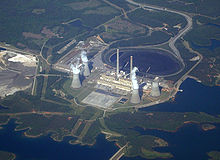Remember the Southern Company brags about “Our competitive generation business”. The important word there is “our”, as in the Southern Company and its subsidiary Georgia Power gets to compete, and you don’t. Unless you’re big enough.
According to the Georgia Public Service Commission:
Some retail competition has been present in Georgia since 1973
with the passage of the Georgia Territorial Electric Service Act. This Act enables customers with manufacturing or commercial loads of 900 kW or greater a one time choice in their electric supplier. It also provides eligible customers the opportunity to transfer from one electric supplier to another provided all parties agree.
This is apparently only one of twelve Georgia laws that impede a competitive solar power market. But this Territoriality Law alone might be enough of an impediment. Here’s a guide, and here’s the text of the Georgia Territorial Electric Service Act.
Because of that law, you can’t you put up solar panels on your own land and sell your power to somebody somewhere else.  And you can’t get a company like SolarCity or Lower Rates for Customers to put up solar panels on your property and sell you the power ( or can you?). Unless you’re generating at least 900 KW; then maybe you can get selected businesses to switch to your power once. Except you probably still won’t qualify, because
Continue reading
And you can’t get a company like SolarCity or Lower Rates for Customers to put up solar panels on your property and sell you the power ( or can you?). Unless you’re generating at least 900 KW; then maybe you can get selected businesses to switch to your power once. Except you probably still won’t qualify, because
Continue reading














